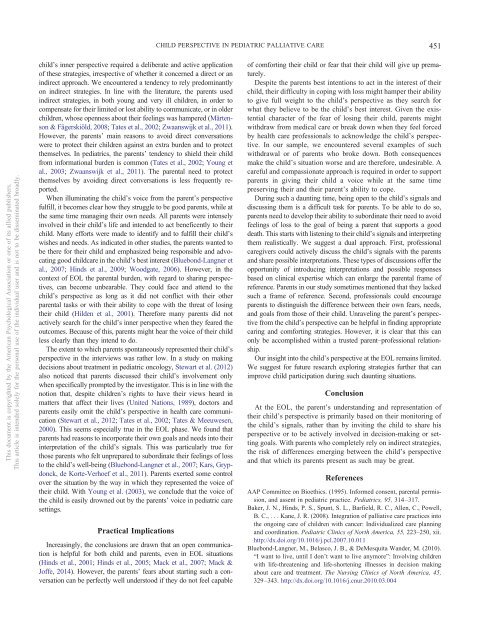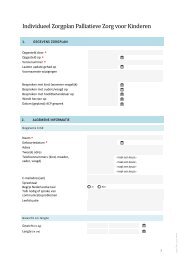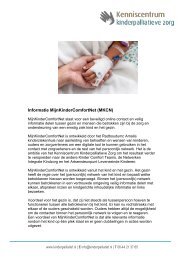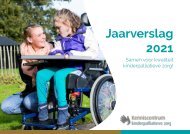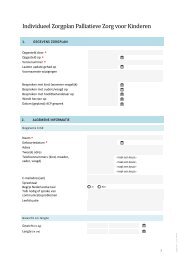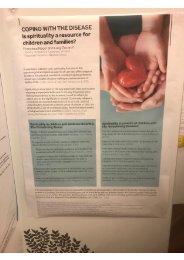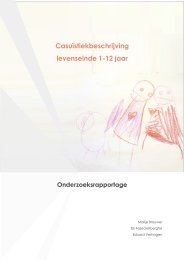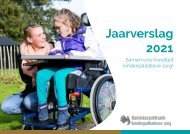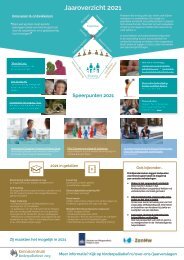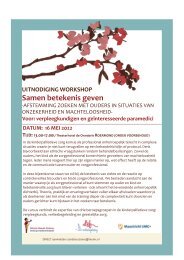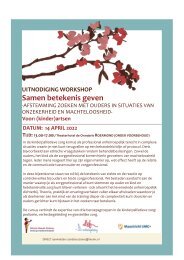The parents’ ability to attend to the "voice of their child" with incurable cancer during the palliative phase
Create successful ePaper yourself
Turn your PDF publications into a flip-book with our unique Google optimized e-Paper software.
CHILD PERSPECTIVE IN PEDIATRIC PALLIATIVE CARE<br />
451<br />
This document is copyrighted by <strong>the</strong> American Psychological Association or one <strong>of</strong> its allied publishers.<br />
This article is intended solely for <strong>the</strong> personal use <strong>of</strong> <strong>the</strong> individual user and is not <strong>to</strong> be disseminated broadly.<br />
child’s inner perspective required a deliberate and active application<br />
<strong>of</strong> <strong>the</strong>se strategies, irrespective <strong>of</strong> whe<strong>the</strong>r it concerned a direct or an<br />
indirect approach. We encountered a tendency <strong>to</strong> rely predominantly<br />
on indirect strategies. In line <strong>with</strong> <strong>the</strong> literature, <strong>the</strong> parents used<br />
indirect strategies, in both young and very ill children, in order <strong>to</strong><br />
compensate for <strong>the</strong>ir limited or lost <strong>ability</strong> <strong>to</strong> communicate, or in older<br />
children, whose openness about <strong>the</strong>ir feelings was hampered (Mårtenson<br />
& Fägerskiöld, 2008; Tates et al., 2002; Zwaanswijk et al., 2011).<br />
However, <strong>the</strong> <strong>parents’</strong> main reasons <strong>to</strong> avoid direct conversations<br />
were <strong>to</strong> protect <strong>the</strong>ir children against an extra burden and <strong>to</strong> protect<br />
<strong>the</strong>mselves. In pediatrics, <strong>the</strong> <strong>parents’</strong> tendency <strong>to</strong> shield <strong>the</strong>ir child<br />
from informational burden is common (Tates et al., 2002; Young et<br />
al., 2003; Zwaanswijk et al., 2011). <strong>The</strong> parental need <strong>to</strong> protect<br />
<strong>the</strong>mselves by avoiding direct conversations is less frequently reported.<br />
When illuminating <strong>the</strong> child’s <strong>voice</strong> from <strong>the</strong> parent’s perspective<br />
fulfill, it becomes clear how <strong>the</strong>y struggle <strong>to</strong> be good parents, while at<br />
<strong>the</strong> same time managing <strong>the</strong>ir own needs. All parents were intensely<br />
involved in <strong>the</strong>ir child’s life and intended <strong>to</strong> act beneficently <strong>to</strong> <strong>the</strong>ir<br />
child. Many efforts were made <strong>to</strong> identify and <strong>to</strong> fulfill <strong>the</strong>ir child’s<br />
wishes and needs. As indicated in o<strong>the</strong>r studies, <strong>the</strong> parents wanted <strong>to</strong><br />
be <strong>the</strong>re for <strong>the</strong>ir child and emphasized being responsible and advocating<br />
good childcare in <strong>the</strong> child’s best interest (Bluebond-Langner et<br />
al., 2007; Hinds et al., 2009; Woodgate, 2006). However, in <strong>the</strong><br />
context <strong>of</strong> EOL <strong>the</strong> parental burden, <strong>with</strong> regard <strong>to</strong> sharing perspectives,<br />
can become unbearable. <strong>The</strong>y could face and <strong>attend</strong> <strong>to</strong> <strong>the</strong><br />
child’s perspective as long as it did not conflict <strong>with</strong> <strong>the</strong>ir o<strong>the</strong>r<br />
parental tasks or <strong>with</strong> <strong>the</strong>ir <strong>ability</strong> <strong>to</strong> cope <strong>with</strong> <strong>the</strong> threat <strong>of</strong> losing<br />
<strong>the</strong>ir child (Hilden et al., 2001). <strong>The</strong>refore many parents did not<br />
actively search for <strong>the</strong> child’s inner perspective when <strong>the</strong>y feared <strong>the</strong><br />
outcomes. Because <strong>of</strong> this, parents might hear <strong>the</strong> <strong>voice</strong> <strong>of</strong> <strong>the</strong>ir child<br />
less clearly than <strong>the</strong>y intend <strong>to</strong> do.<br />
<strong>The</strong> extent <strong>to</strong> which parents spontaneously represented <strong>the</strong>ir child’s<br />
perspective in <strong>the</strong> interviews was ra<strong>the</strong>r low. In a study on making<br />
decisions about treatment in pediatric oncology, Stewart et al. (2012)<br />
also noticed that parents discussed <strong>the</strong>ir child’s involvement only<br />
when specifically prompted by <strong>the</strong> investiga<strong>to</strong>r. This is in line <strong>with</strong> <strong>the</strong><br />
notion that, despite children’s rights <strong>to</strong> have <strong>the</strong>ir views heard in<br />
matters that affect <strong>the</strong>ir lives (United Nations, 1989), doc<strong>to</strong>rs and<br />
parents easily omit <strong>the</strong> child’s perspective in health care communication<br />
(Stewart et al., 2012; Tates et al., 2002; Tates & Meeuwesen,<br />
2000). This seems especially true in <strong>the</strong> EOL <strong>phase</strong>. We found that<br />
parents had reasons <strong>to</strong> incorporate <strong>the</strong>ir own goals and needs in<strong>to</strong> <strong>the</strong>ir<br />
interpretation <strong>of</strong> <strong>the</strong> child’s signals. This was particularly true for<br />
those parents who felt unprepared <strong>to</strong> subordinate <strong>the</strong>ir feelings <strong>of</strong> loss<br />
<strong>to</strong> <strong>the</strong> child’s well-being (Bluebond-Langner et al., 2007; Kars, Grypdonck,<br />
de Korte-Verhoef et al., 2011). Parents exerted some control<br />
over <strong>the</strong> situation by <strong>the</strong> way in which <strong>the</strong>y represented <strong>the</strong> <strong>voice</strong> <strong>of</strong><br />
<strong>the</strong>ir child. With Young et al. (2003), we conclude that <strong>the</strong> <strong>voice</strong> <strong>of</strong><br />
<strong>the</strong> child is easily drowned out by <strong>the</strong> <strong>parents’</strong> <strong>voice</strong> in pediatric care<br />
settings.<br />
Practical Implications<br />
Increasingly, <strong>the</strong> conclusions are drawn that an open communication<br />
is helpful for both child and parents, even in EOL situations<br />
(Hinds et al., 2001; Hinds et al., 2005; Mack et al., 2007; Mack &<br />
J<strong>of</strong>fe, 2014). However, <strong>the</strong> <strong>parents’</strong> fears about starting such a conversation<br />
can be perfectly well unders<strong>to</strong>od if <strong>the</strong>y do not feel capable<br />
<strong>of</strong> comforting <strong>the</strong>ir child or fear that <strong>the</strong>ir child will give up prematurely.<br />
Despite <strong>the</strong> parents best intentions <strong>to</strong> act in <strong>the</strong> interest <strong>of</strong> <strong>the</strong>ir<br />
child, <strong>the</strong>ir difficulty in coping <strong>with</strong> loss might hamper <strong>the</strong>ir <strong>ability</strong><br />
<strong>to</strong> give full weight <strong>to</strong> <strong>the</strong> child’s perspective as <strong>the</strong>y search for<br />
what <strong>the</strong>y believe <strong>to</strong> be <strong>the</strong> child’s best interest. Given <strong>the</strong> existential<br />
character <strong>of</strong> <strong>the</strong> fear <strong>of</strong> losing <strong>the</strong>ir child, parents might<br />
<strong>with</strong>draw from medical care or break down when <strong>the</strong>y feel forced<br />
by health care pr<strong>of</strong>essionals <strong>to</strong> acknowledge <strong>the</strong> child’s perspective.<br />
In our sample, we encountered several examples <strong>of</strong> such<br />
<strong>with</strong>drawal or <strong>of</strong> parents who broke down. Both consequences<br />
make <strong>the</strong> child’s situation worse and are <strong>the</strong>refore, undesirable. A<br />
careful and compassionate approach is required in order <strong>to</strong> support<br />
parents in giving <strong>the</strong>ir child a <strong>voice</strong> while at <strong>the</strong> same time<br />
preserving <strong>the</strong>ir and <strong>the</strong>ir parent’s <strong>ability</strong> <strong>to</strong> cope.<br />
During such a daunting time, being open <strong>to</strong> <strong>the</strong> child’s signals and<br />
discussing <strong>the</strong>m is a difficult task for parents. To be able <strong>to</strong> do so,<br />
parents need <strong>to</strong> develop <strong>the</strong>ir <strong>ability</strong> <strong>to</strong> subordinate <strong>the</strong>ir need <strong>to</strong> avoid<br />
feelings <strong>of</strong> loss <strong>to</strong> <strong>the</strong> goal <strong>of</strong> being a parent that supports a good<br />
death. This starts <strong>with</strong> listening <strong>to</strong> <strong>the</strong>ir child’s signals and interpreting<br />
<strong>the</strong>m realistically. We suggest a dual approach. First, pr<strong>of</strong>essional<br />
caregivers could actively discuss <strong>the</strong> child’s signals <strong>with</strong> <strong>the</strong> parents<br />
and share possible interpretations. <strong>The</strong>se types <strong>of</strong> discussions <strong>of</strong>fer <strong>the</strong><br />
opportunity <strong>of</strong> introducing interpretations and possible responses<br />
based on clinical expertise which can enlarge <strong>the</strong> parental frame <strong>of</strong><br />
reference. Parents in our study sometimes mentioned that <strong>the</strong>y lacked<br />
such a frame <strong>of</strong> reference. Second, pr<strong>of</strong>essionals could encourage<br />
parents <strong>to</strong> distinguish <strong>the</strong> difference between <strong>the</strong>ir own fears, needs,<br />
and goals from those <strong>of</strong> <strong>the</strong>ir child. Unraveling <strong>the</strong> parent’s perspective<br />
from <strong>the</strong> child’s perspective can be helpful in finding appropriate<br />
caring and comforting strategies. However, it is clear that this can<br />
only be accomplished <strong>with</strong>in a trusted parent–pr<strong>of</strong>essional relationship.<br />
Our insight in<strong>to</strong> <strong>the</strong> child’s perspective at <strong>the</strong> EOL remains limited.<br />
We suggest for future research exploring strategies fur<strong>the</strong>r that can<br />
improve child participation <strong>during</strong> such daunting situations.<br />
Conclusion<br />
At <strong>the</strong> EOL, <strong>the</strong> parent’s understanding and representation <strong>of</strong><br />
<strong>the</strong>ir child’s perspective is primarily based on <strong>the</strong>ir moni<strong>to</strong>ring <strong>of</strong><br />
<strong>the</strong> child’s signals, ra<strong>the</strong>r than by inviting <strong>the</strong> child <strong>to</strong> share his<br />
perspective or <strong>to</strong> be actively involved in decision-making or setting<br />
goals. With parents who completely rely on indirect strategies,<br />
<strong>the</strong> risk <strong>of</strong> differences emerging between <strong>the</strong> child’s perspective<br />
and that which its parents present as such may be great.<br />
References<br />
AAP Committee on Bioethics. (1995). Informed consent, parental permission,<br />
and assent in pediatric practice. Pediatrics, 95, 314–317.<br />
Baker, J. N., Hinds, P. S., Spunt, S. L., Barfield, R. C., Allen, C., Powell,<br />
B.C.,...Kane, J. R. (2008). Integration <strong>of</strong> <strong>palliative</strong> care practices in<strong>to</strong><br />
<strong>the</strong> ongoing care <strong>of</strong> children <strong>with</strong> <strong>cancer</strong>: Individualized care planning<br />
and coordination. Pediatric Clinics <strong>of</strong> North America, 55, 223–250, xii.<br />
http://dx.doi.org/10.1016/j.pcl.2007.10.011<br />
Bluebond-Langner, M., Belasco, J. B., & DeMesquita Wander, M. (2010).<br />
“I want <strong>to</strong> live, until I don’t want <strong>to</strong> live anymore”: Involving children<br />
<strong>with</strong> life-threatening and life-shortening illnesses in decision making<br />
about care and treatment. <strong>The</strong> Nursing Clinics <strong>of</strong> North America, 45,<br />
329–343. http://dx.doi.org/10.1016/j.cnur.2010.03.004


